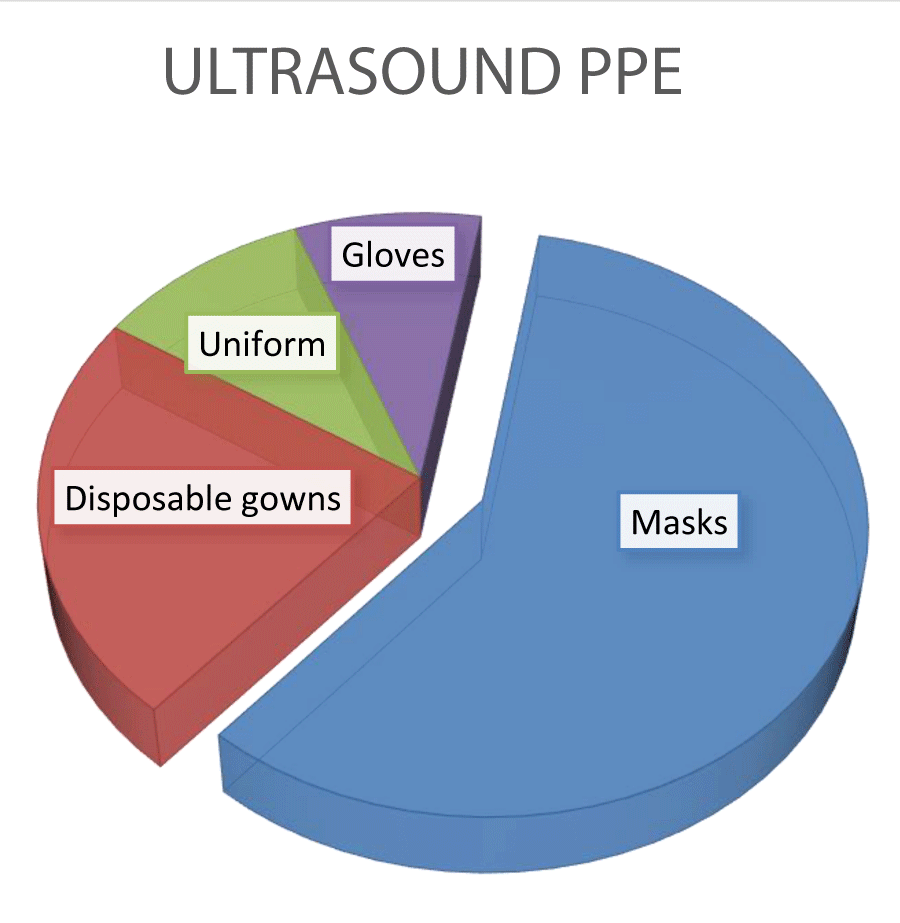Archives of Nursing Practice and Care
Ultrasound Precautions during COVID-19 Pandemic
Delores Jones*
Cite this as
Jones D (2022) Ultrasound Precautions during COVID-19 Pandemic. Arch Nurs Pract Care 8(1): 007-009. DOI: 10.17352/2581-4265.000059Copyright License
©2021 Jones D. This is an open-access article distributed under the terms of the Creative Commons Attribution License, which permits unrestricted use, distribution, and reproduction in any medium, provided the original author and source are credited.An epidemic that travels throughout the world is called a pandemic [1]. There have been several pandemics that have impacted the world. One example of a pandemic that became global is Spanish influenza. This pandemic was very severe and attacked more than 30% of the world population. Approximately 50 million people died from the first outbreak. Another type of pandemic that impacted the world is the bubonic plague; also known as the Black Death. Many people died from this medical condition. Other examples of pandemics include severe acute respiratory syndrome (also called SARS virus) and cholera, and influenza [2]. In 2019 a new pandemic erupted in the world. This pandemic was first identified in China in December 2019 but quickly spread throughout the United States and the world in 2020. This pandemic is called the COVID-19 or the coronavirus. COVID-19 has impacted the day-to-day operations of many industries including the medical industry. This article will define what COVID-19 is and how ultrasound has created precautions to help keep medical staff and patients safe during this pandemic.
COVID-19 pandemic has created large impacts on the United States as well as several other countries. COVID-19 has become approximately the 3rd leading cause of death in 2020 [3]. Additionally, Covid has resulted in lost wages and negative effects on economics in America. This pandemic has impacted several industries including the health care industry. There have been fewer medical workers to fill various medical positions. However, since 2020, there have been surges in patients seeking medical treatment due to a large number of patients experiencing symptoms as a result of the COVID-19 virus. Therefore, to preserve the safety of medical workers and patients that are already in the hospital (or outpatient facilities) many facilities have gotten a protocol for Covid Safety precautions. The preceding paragraphs will explain what COVID-19 is and what precautions are in place in the ultrasound industry to protect the staff and patients.
COVID-19 defined
The coronavirus is a respiratory disease that occurred first in Wuhan China in December of 2019. This particular virus transferred easily and was caused by SARS-CoV-2 also called the COVID-19 virus. This virus quickly became a pandemic in 2020 and traveled across many countries of the world [4]. This contagious virus often feels like the flu or pneumonia when it first invades a person’s system. However, COVID-19 attacks your respiratory system and many other organ systems in the body. The coronavirus may attack any organ in the systems within the body. For example, the lungs are often attacked within the respiratory system in people who have this virus. As a result, many people end up with pneumonia (fluid in the lungs) or with bronchitis (severe cough as a result of the respiratory system). Table 1 lists a quick reference for systems and organs that may be attacked when there is coronavirus within the body.
Figure 1 lists organs and systems of the body that may have associated conditions as a result of the coronavirus. Some of the organs that can be attacked are all organs within the nervous, respiratory, skeletal, muscular, digestive, endocrine, lymphatic, cardiovascular, reproductive, and urinary systems.
Some people that have this virus become mildly sick (like the flu). In contrast, there are many more people that become severely ill as a result of COVID-19. The worst outcome for some people that obtain COVID-19 is death from complications [4]. There are a variety of symptoms that people with this virus present with. Even after the COVID-19 virus has passed through a person (and they no longer have the virus), they may still experience symptoms from lingering effects of this medical condition. Symptoms that people may present during or after having COVID-19 are difficulty breathing or shortness of breath, coughing, tiredness, difficulty focusing, and brain fog. Additionally, pain can occur throughout the body. Whether it is the pins and needle feeling, pain from rapid heartbeats, or joint and muscle pain. There can also be diarrhea, inability to sleep, fever, dizziness, rash, and changes in menstrual periods. Some people that have COVID also experience impacts on their taste buds, smells, and mood swings [4].
Please note that some of these symptoms may occur still with post-COVID-19. The symptoms of pain or discomfort may occur in any of the organs or parts of the body. Needle pain or rapid heartbeat may also occur. Additionally sleep, mood or menstrual changes may occur.
COVID-19 precautions in ultrasound
As a result of the pandemic, there have been rules and protocols that have been placed to ensure a safe environment for medical professionals as well as patients [5]. Ultrasound has implemented several precautions and protocols to ensure safety and help eliminate the spread of the COVID-19 virus. In the proceeding paragraphs, four precautions within the ultrasound department or facility will be discussed in detail below.
Social distance
One of the methods that the CDC recommends for maintaining safety during the pandemic, is social distancing. This recommendation is very important for health care facilities to implement for the safety of staff and patients. A minimum of 6 feet is recommended. In any radiologic facility, proper distancing is a priority. The ultrasound department helps maintain distance in the waiting area by spreading patient seating. Having space in between furniture and chairs helps with maintaining distance between patients. Additionally, most ultrasound facilities only allow one guest with each patient to eliminate overcrowding in waiting areas. Another method that helps with social distancing is the scheduling of patients. Patients are no longer overbooked. Patients are spread out so that there are fewer opportunities to overcrowd the facility. Lastly, digital check-ins are often utilized to prevent unnecessary patient contact ( [6].
Personal protective equipment
Personal protective equipment (also called PPE) is utilized by all ultrasound staff. Personal protective equipment helps to minimize the risk of performing ultrasounds on patients that may have the COVID-19 virus. Figure 2 lists some of the personal protective equipment that is utilized in the ultrasound department. The items listed within the figure are gloves, uniforms, gloves, and masks. Clean uniforms daily must be worn to work. If the uniform becomes soiled there should be extra uniforms at work for ultrasound staff to change in. N95 masks are usually the mask of choice for medical professionals. However, some staff may decide to wear washable or disposable masks to work. Hand washing and gloves are of top importance and essential for all ultrasound staff. Before and after contact with each patient, hands should be washed and new gloves should be applied whenever new exams are performed [7].
Figure 2 lists some of the personal protective equipment that Sonographers may utilize to maintain the safety of the patients and themselves during the COVID-19 pandemic. The main 4 items that are utilized are masks, disposable gowns, uniforms, and gloves.
Room preparation
Room preparation is very important in the ultrasound facility to help eliminate and minimize the transfer of pathogens such as COVID-19. Ultrasound personnel should make sure that the ultrasound rooms are sanitized before the start of scanning patients for the day. All surfaces and ultrasound equipment should be disinfected. Any room décor or accessories that are cloth-based or not easy to sanitize should be removed if not necessary. In between each patient, the Sonographer should re-sanitize everything including the examining bed and couch. The new paper should be applied to cover the bed if applicable (instead of using sheets). It is important to note that any patients that have suspected or confirmed cases of the COVID-19 virus should be scanned toward the end of the day. This allows for extra time to clean and disinfect after these patients are infected with this virus [6].
Disinfecting equipment
Just as room preparation is important, the actual disinfecting of the ultrasound machine is important. All parts of the ultrasound should be disinfected between patients. Ultrasound cables and transducers should be disinfected in between each patient. It is important to note that many ultrasound departments have specific ultrasound machines that are dedicated to patients with confirmed or suspected cases of COVID-19. Any parts of the ultrasound machine (such as extra transducers) should be stored in a cabinet (out of the way). Only transducers needed for scheduled exams should be out. Single-use transducer gels (nonsterile) should be used for daily scanning. If possible, no gel bottles should be used. If the ultrasound facility or department is out of the non-sterile gel packets, then bottles may be used for external exams only. The gel bottles should not be refilled or heated. It should be tossed in the trash after gel bottles are emptied from use [7].
There have been many public health measures that help decrease the spread of the COVID-19 virus. Physical distancing, face masks, hand washing, and decreased social gatherings are some of the measures that have been put in place to minimize the spread of this pandemic [2]. Despite the regulations and measurements that have been put in place, the pandemic has put a strain on many industries. The COVID-19 pandemic has impacted industries all over the world, especially the healthcare industry [3]. Since the occurrence of this pandemic there has been a strain on medical facilities trying to treat and care for patients while trying to maintain the safety of health care workers. Ultrasound specifically plays an important role in the treatment and care of patients in medical facilities. Ultrasound exams such as point-of-care ultrasounds provide safe approaches for helping radiologists diagnose patients without using radiation (such as with x-rays and CT scans). Ultrasound helps with identifying and managing patients with COVID-19.
- Grennan D (2019) What Is a Pandemic. JAMA 321:910. Link: https://bit.ly/3sZ6fZH
- Piret J, Boivin G (2021) Pandemics Throughout History. Front Microbiol11: 631736. Link: https://bit.ly/3MBhWxx
- Kaye AD, Okeagu CN, Pham AD, Silva RA, Hurley JJ, et al. (2021) Economic impact of COVID-19 pandemic on healthcare facilities and systems: International perspectives. Best Pract Res Clin Anaesthesiol 35: 293–306. Link: https://bit.ly/3tSeXZ8
- Centers of Disease and Control and Prevention. (CDC) (2021) Basics of Covid-19. Link: https://bit.ly/3tPmIit
- Kumar S, Kumar A, Goel P, Vyas S, Baitha U, et al. (2020) Use of ultrasonography in COVID-19: Probing for success. J Family Med Prim Care 9: 3863–3866. Link: https://bit.ly/3HZdrt7
- Greenway Health (2022) Social distancing: Waiting room tips for a better experience. Link: https://bit.ly/3MEC29X
- Pablos T (2020) Five steps to safe scanning with ultrasound during COVID-19. AuntMinnie.com. Link: https://bit.ly/3KAVFxN

Article Alerts
Subscribe to our articles alerts and stay tuned.
 This work is licensed under a Creative Commons Attribution 4.0 International License.
This work is licensed under a Creative Commons Attribution 4.0 International License.


 Save to Mendeley
Save to Mendeley
